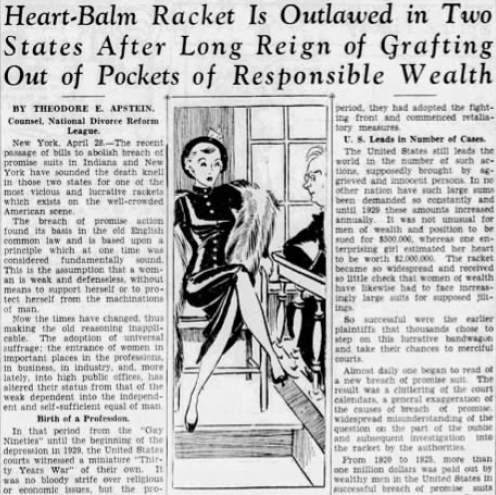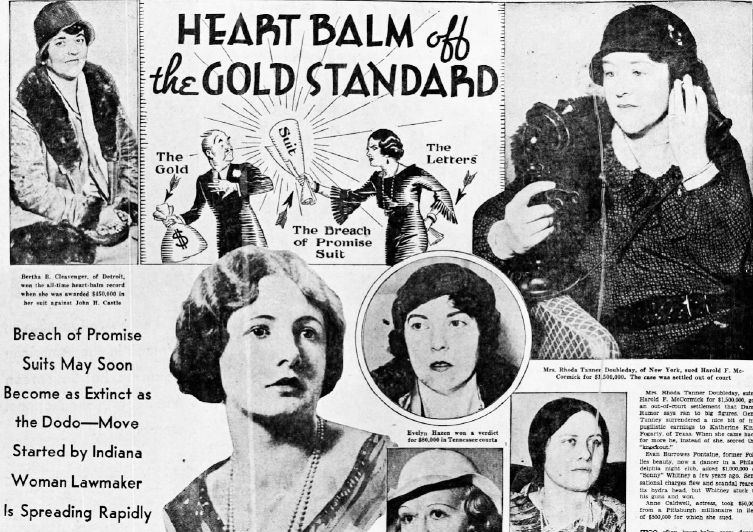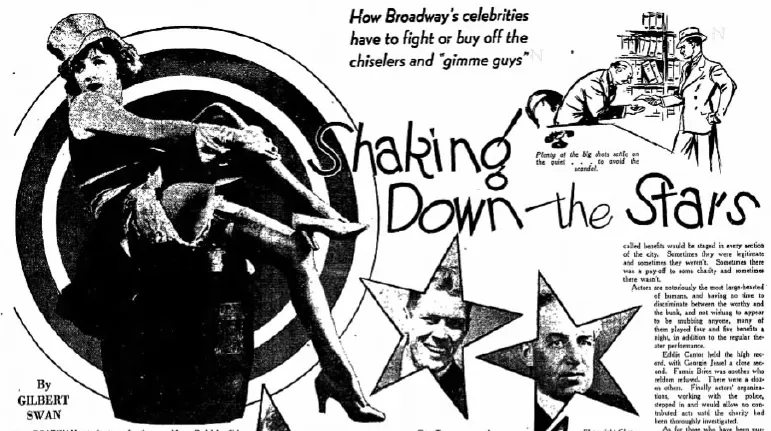How the “Heart Balm Racket” Convinced America That Women Were Up to No Good
Being engaged carried some legal consequences until the news media got a hold of a sensational story
/https://tf-cmsv2-smithsonianmag-media.s3.amazonaws.com/filer/7b/6d/7b6d7702-bf02-425e-a537-fd4b9cb2cffe/screen_shot_2018-02-12_at_51959_pm.png)
She was 27, with a “winning smile” and a penchant for hanging around ocean liners. He was 45, a widower with an 18-year-old daughter, and they were sailing to Europe for the summer. The two girls became fast friends and spent a delightful trip together, innocent as could be.
But all along, this “Siren on Ocean Liner”—as the Washington Post called her—was plotting. After traveling through Europe with the family, the woman, also referred to as Myrtle MaGee by the papers, visited them back in the States (where she secretly destroyed all the letters she’d written to the widower’s daughter, effectively erasing the platonic nature of her relationship to the family). She then blithely launched a lawsuit against the widower, claiming that he had promised to marry her and was now trying to back out of it.
This case, reported breathlessly by the Washington Post in 1915, was not an isolated incident. In fact, it was only one in a long line of scandalous, seedy, and over-reported cases in which unscrupulous women tried to blackmail wealthy men out of large sums of money, helped along by a weird little piece of legislation that allowed people to sue their exes after a broken engagement. These ladies were “gold-diggers,” “schemers” and “adventuresses,” and what they were doing, the papers crowed, was nothing short of a racket.
The legislation in question was something called the “breach of promise” or “heart balm” suit, and it was based on the premise that an engagement was a binding contract between two people. If one person were to break off the contract without consulting the other, the law could step in and award damages to the brokenhearted party.
Granted, no one was terribly happy about these laws in the first place—feminists thought they made women look dependent, while misogynists thought they allowed women to tap into their naturally devious natures—but as controversial, high-profile breach of promise suits kept making the papers, the public grew increasingly paranoid about the implications of such legislation. By 1935, the paranoia had grown so extreme that lawmakers were calling for a wholesale elimination of heart balm laws, and soon enough states were abolishing them right and left—abolishing them so quickly, in fact, that the constitutionality of some of the reform statues was later called into question. Still, the message had been made clear: it was no longer possible to sue over a shattered heart, real or false.
**********

The idea that people should be punished for trying to back out of an engagement was nothing new in 1935. For centuries, it was possible to take action—first through the church, and then in the courtroom—against the one who loved and left you. (The earliest successful breach of promise suit took place in 1638; men could—and occasionally did—sue their ex-fiancées, but the legislation was mostly used by women.) Opponents of these suits mocked them as either “blackmail or vulgarity unspeakable,” but there was nothing silly or saccharine about the underlying premise, at least not at first. For most of human history, marriage was an extraordinarily practical arrangement, one with significant financial and social benefits, especially for women. Getting engaged meant you could start anticipating those benefits—and you might change your actions accordingly. You might, for example, begin spending money on an expensive trousseau. You might enjoy a change in social status. You would almost certainly break it off with all other marriage prospects. And you might finally decide to sleep with your fiancéé.
A bride’s virginity was still a pretty big deal in the 1920s and 1930s (and remained that way until at least the 1950s), but engagement provided something of a loophole. Women who were intent on remaining virgins until marriage might consider engagement close enough—and so, if their fiancé suddenly broke things off, they found themselves dealing with a literal drop in value. A broken engagement didn’t just mean a loss of future income, but it could damage a woman’s reputation and make it harder for her to get engaged again. Even if she’d never actually had sex, there was a chance she’d be tainted by association.
Into this land of hearts and hymens, the law strode bravely. These heart balm laws were unusual, to say the least: no matter how many times you argued financial loss, or tried to put virginity into a legal box, the core of these suits was something uncomfortably personal. “Clearly the principal ground of the action is disappointed hope, and the injury complained of is a violation of faith,” wrote one lawyer in 1906.
The question was how to turn “disappointed hope” and “violation of faith” into cold hard cash. Juries found themselves compensating plaintiffs for things like, “loss of social and worldly advancement,” “disappointment and incidental suffering,” injury to future marriage prospects, and even emotions like experiencing humiliation “in the social circles in which she moves.” The fact that these compensations all seemed to rely on “emotional sympathy and moral indignation,” as another lawyer wrote in 1935, made some people uncomfortable—especially as all-male juries seemed to be passing down awfully lucrative settlements when the plaintiff was a very pretty woman and the defendant was a very rich man.

Naturally, these lucrative settlements—with their whiff of sex and drama—were big news, especially when women were walking out of the courtroom with $100,000, $200,000, or even $450,000 from their former suitors. This wasn’t justice, the papers said. This wasn’t restitution. This was a racket—a heart balm racket. And they weren’t entirely wrong.
**********
“Fair Sirens Who Seek to Blackmail Rich Men Weave Cunning Webs Which Enmesh Innocent in Hopeless Tangle,” crowed that Washington Post report on that “Siren on Ocean Liner” and all sorts of other nefarious females who used the slipperiness of heart balm laws to con upstanding men out of hundreds of thousands of dollars. The article claimed that female blackmailers were lurking around restaurants, cafes, hotels and other affluent watering holes, where they would pick up wealthy, unsuspecting men, go on a few dates with them (ensuring that they’d be spotted by witnesses or even secretly photographed), and then slap them with a breach of promise suit. As far as the innocent widower from the ocean liner? Upon receiving notice of the lawsuit against him, the article reported that he was “stunned almost out of his senses.”
Polite society, too, was stunned out of their senses by the idea that women with winning smiles were wreaking havoc on men with the aid—nay, with the blessing of the legal system. These dodgy lawsuits played perfectly on people’s fears, tapping into the worst possible clichés of the battle of the sexes: dumb men seduced into trouble, wicked women using their looks for evil. It wasn’t that people thought all jilted women were evil; they just thought that innocent women didn’t sue.
“A woman whose heart is really broken doesn’t take it into court,” wrote the popular advice columnist Dorothy Dix in 1915, and this sentiment was shared by many. A woman shrewd enough to save love letters as future evidence surely wasn’t the bruised, delicate flower she claimed to be.
To be fair, the public’s hysteria had some basis in reality. A particularly bold lady blackmailer who went by the name Chicago May ran so many heart balm rackets that she boasted about them in her 1928 memoir. One involved a wealthy suitor who started sending her dirty drawings out of nowhere—the perfect evidence for a fake heart balm suit. (“The drawing was fairly good, but the subject matter was revolting,” she noted.) At one point, she was even conducting her blackmail business intercontinentally: living in London but occasionally popping back over to New York to check up on a heart balm racket or two. She referred to these as her “American investments.”

Still, the angry editorials and cries for abolishment were mostly fueled by paranoia, not practicality. “Reading the editorials…one would conclude that there had seldom been an actual contract of engagement to marry that was unjustifiably broken,” one lawyer wrote in the Fordham Law Review. “The experience of practicing lawyers is decidedly otherwise.” It was “undue newspaper publicity,” another lawyer argued in the Michigan Law Review, that led to this impassioned public outcry against breach of promise suits. While there were plenty of ordinary suits led by ordinary jilted women (and occasionally a jilted man), it was the sleazy, salacious, high-profile cases that convinced people that these breach of promise laws had to go, and go fast.
It wasn’t just the sleaziness that bothered people, though. Women’s roles were changing, and the core premise behind the breach of promise laws—that a broken engagement could wreck a woman’s future—was weakening. A woman dumped by her fiancé in 1930 wasn’t ruined the way she might have been a mere generation earlier. “There are many, many ways in which a girl can now earn her own living,” one journalist noted in The Hartford Courant. By the mid-1930s, public sympathy for the brokenhearted had mostly drained away, and the breach of promise suit was on its deathbed.
**********
In 1935, a young state legislator named Roberta West Nicholson introduced an anti-heart balm bill in Indiana. Other states quickly followed her lead, and by 1945, 16 states had abolished the breach of promise laws. Today, only a few jurisdictions still cling to them. (You’ll have to move to, say, North Carolina if you want to sue an ex-fiancé.)
Some violently opposed Nicholson’s bill—one senator noted that it removed women’s civil rights “against philanderers and men who prey upon them.” Others praised her, while misunderstanding her reasons for writing the bill. To this day, certain men’s rights activists love Nicholson for leading the charge against what they see as a war on men; an “Anti-Misandry Legislator,” they call her. The irony is that Nicholson wrote the bill not to protect men, but because she thought women were better than heart balm. “I was pretty young and didn’t realize at first I was challenging a basic common law, that the woman was a chattel and that the man, in marrying her, was saying, ‘I buy you and agree to feed and clothe you,’” she told a journalist decades later. “I was an early woman’s libber and didn’t know it.”
Yes, the outcry against the so-called heart balm racket wasn’t just from people convinced that unscrupulous women were abusing the system. There was an odd feminism to it. “It is gallantry gone to seed,” wrote Dix. “Moreover, it is not justice, for a woman capable of bringing suit is perfectly able to take care of herself in a love affair or any other business deal.”
Where once marriage was something that gave women some semblance of power, now—the critics said—women had power of their own, married or not. They could make their own money. They could work on their own American investments. They were no longer defenseless, and so they did not need the law to defend them. In the midst of all the paranoia about blackmail and “vulgarity unspeakable,” a surprisingly modern portrait of marriage was emerging: a union of two people who could make up their own minds about each other and didn’t need the law to save them from themselves.